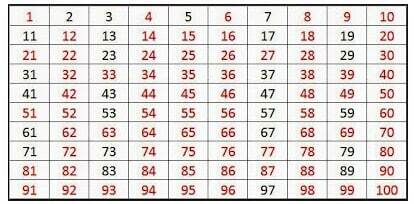Composite Numbers: Symbols And Examples Of Composite Numbers
Composite number– Is a natural number greater than 1 which is not a prime number. The following is a complete explanation of composite numbers. The discussion this time is about the meaning of composite numbers, examples of composite numbers, examples of composite numbers that are less than 10, examples of composite numbers less than 20 and so on. For more details, see the discussion below

Table of contents :
Composite number
Composite numbers are natural numbers more than 1 that are not prime numbers. In addition, composite numbers are whole numbers other than 1 and 0 and are not prime numbers. Composite numbers also have another term, namely structured numbers. Composite numbers also have factors greater than two.
Below is a table of examples of composite numbers 1 to 100

Composite numbers can be expressed as an integer factorization, or the product of two or more prime numbers. The first ten composite numbers are 4, 6, 8, 9, 10, 12, 14, 15, 16, and 18. Or it can also be called a number that has the number of factors more than two.
Example of Composite Numbers
Based on the definitions above, it can be concluded that examples of composite numbers are
1. Composite number less than 10 (ten)
( 4, 6, 8, 9 )
2. In the first ten composite numbers
(4, 6, 8, 9, 10, 12, 14, 15, 16, and 18 )
3. Composite number less than 20
(4, 6, 8, 9, 10, 12, 14, 15, 16, and 18 )
4. Composite number on dice
( 4, 6 )
5. Composite Number 1-100
4, 6, 8, 9, 10, 12, 14, 15, 16, 18, 20, 21, 22, 24, 25, 26, 27, 28, 30, 32, 33, 34, 35, 36, 38, 39, 40, 42, 44, 45, 46, 48, 49, 50, 51, 52, 54, 55, 56, 57, 58, 60, 62, 63, 64, 65, 66, 68, 69, 70, 72, 74, 75, 76, 77, 78, 80, 81,82, 84, 85, 86, 87, 88, 90, 91, 92, 93, 94, 95, 96, 98, 99, 100
Example A:
The number 4 is a composite number
The number 4 can be divided by the numbers 1, 2, and 4
Divided by 1 i.e. 4:1 is 4
Divided by himself i.e. 4: 4 is 1
Divided by any other number i.e. 4: 2 is 2 (Composite Condition)
So it is known that 4 is obtained by multiplying 2 prime numbers, namely 2 × 2
Example B:
7 is not part of a composite number
The number 7 is only divisible by 1 and 7, so 7 only has 2 factors. Henceforth the number 7 is called a prime number.
So it can be seen that every number that is a prime number is not a composite.
Symbol of the set of composite numbers
In general, there is no special symbol for composite numbers, however, to express a composite number often use the letter 'K' symbol (uppercase k).
The set of composite numbers
1. The set of composite numbers less than 10 (ten)
K = { 4, 6, 8, 9 }
So, the members of the set of composite numbers less than 10 are 4. i.e. 4, 6, 8 and 9
2. The set of the first ten composite numbers
K ={ 4, 6, 8, 9, 10, 12, 14, 15, 16, and 18 }
Then the sets of the first ten composite numbers are 4, 6, 8, 9, 10, 12, 14, 15, 16, and 18
3. The set of numbers in composites less than 20
K = { 4, 6, 8, 9, 10, 12, 14, 15, 16, 18 }
So, the set of numbers in the composite which has less than 20 elements is 10.
That's the discussion about composite numbers, hopefully it's useful
Other Articles:
- Related Angle Formulas: Quadrant Formulas 1, 2, 3, 4 and Example Problems
- The formula for the base of a triangle along with the formula for height and example questions
- Spherical Surface Area Formula and Example Problems Contoh
- Definition, Properties, Quadratic Equation Formulas and Example Problems
